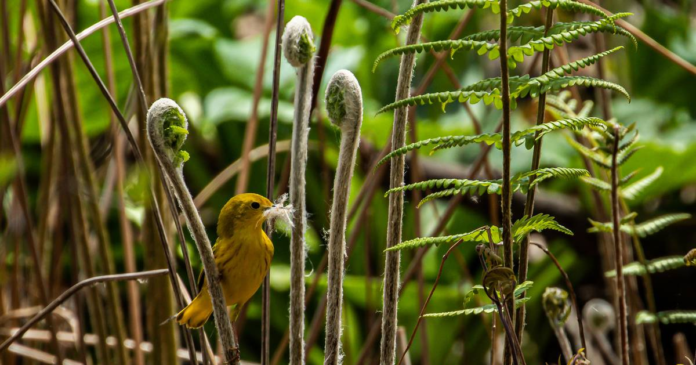An American yellow warbler builds a nest at Cowles Bog in the Indiana Dunes National Park on May 18, 2019. (Zbigniew Bzdak / Chicago Tribune)
It’s time to pay more attention to the often-overlooked natural assets in the Calumet region of Northwest Indiana and southeast Chicago, a recent report argues.
Looking to focus attention on the region’s natural woods, rivers and wetlands as well as its dunes, the Calumet Land Conservation Partnership recently released a report, Conservation Action Planning in the Calumet Region.
Advertisement
The report, available online at www.savedunes.org/resources, identifies broad plans for enhancing and conserving natural areas in the Calumet region.
Grand Calumet River at Miller Woods in the Indiana Dunes National Park in Gary on Sunday, Aug. 25, 2019. (Zbigniew Bzdak/Chicago Tribune) (Zbigniew Bzdak / Chicago Tribune)
“It makes the case that there’s great nature in the region, not just at the lakeshore,” said Mark Bouman, Chicago Region Program director at the Field Museum in Chicago.
Advertisement
The report outlines strategies “to protect landscapes, restore native habitats, create accessible and healthy river corridors, and develop resilient coastal communities,” the Calumet Land Conservation Partnership’s news release says.
“Preserving lands and waters improves human and wildlife health, protects rate species, and brings the benefits of nature to the people of a region that has been challenged by more than a century of industrial and urban development.”
Para-athletes begin the swimming portion of Leon’s Triathlon at Wolf Lake. ( Suzanne Tennant/The Post Tribune / Suzanne Tennant/Post-Tribune )
The report includes Conservation Action Plans for four areas of the region:
• Heart of Calumet, the bi-state area that includes Lake Calumet, Wolf Lake and George Lake and the Indiana Harbor Ship Canal, and the communities around those. Natural areas include dune-and-swale remnants, wetlands and lakes.
• Ecosystems of the Indiana Dunes, along the Lake Michigan shoreline between Miller Woods on the west and the Great Marsh on the east.
Great Marsh at the Indiana Dunes National Park in Beverly Shores on Thursday, Aug. 23, 2019. (Zbigniew Bzdak/Chicago Tribune) (Zbigniew Bzdak / Chicago Tribune)
• East branch of the Little Calumet River, from the river’s start in LaPorte County to the Portage Lakefront, including Coffee Creek, Salt Creek and Reynolds Creek.
Salt Creek, which includes a small bridge along West Street near the intersection of U.S. 30 and Horse Prairie Avenue, is one of the areas targeted for conservation. (Philip Potempa / Post-Tribune)
• Hobart Marsh and Deep River in Lake County, which the report calls “a diverse landscape that includes several habitat types within a relatively developed area.”
This image shows Big Maple Lake, a section of the Deep River County Park in unincorporated Lake County, just east of Indiana 51, one of the areas targeted for conservation. (Carole Carlson / Post-Tribune)
Other natural areas in the report are Hoosier Prairie, in Griffith, Schererville and Merrillville; the West Branch of the Little Calumet River, between Indianapolis Boulevard on the west to Deep River on the east; the Illinois branch of the Little Calumet River, the Moraine/Sunset Hill area of Porter County; and the Ambler Flatwoods area east of Michigan City.
Advertisement
Local environmentalists protest the dangers of the tar sands oil pipeline that runs below Hoosier Prairie State Nature Preserve in Schererville in this 2017 file photo. (Suzanne Tennant / Post-Tribune )
The groups that put the report together are planning now to get more public involvement in conserving the region’s natural areas.
They want to reach out to communities mentioned in the report to discuss “how this resource can be integrated into municipal-scale planning processes,” Katie Hobgood, program director for Save the Dunes, said in an email.
“Our group is currently exploring funding opportunities to support a robust engagement process in the near future,” she wrote.
Bouman said the Calumet Land Conservation Partnership was put together 10 years ago with funding from the Donnelley Foundation and Arcelor Mittal (the steel company predecessor to Cleveland-Cliffs).
“They wanted to see more collaboration and communication between conservation partners in the Calumet Region,” he said. “There’s a lot of opportunities but a lot of challenges in the region.”
An organization called Chicago Wilderness Alliance put together a “green infrastructure” map of the region about 12 years ago that emphasized connecting natural areas to each other.
Advertisement
About five years ago, Bouman said, funding from the Coastal Zone Management program allowed Save the Dunes and Chicago-based Calumet Collaborative to prepare conservation action plans for Hoosier Prairie, the Moraine area, and Ambler Flatwoods.
The latest report also ties in to another project Bouman has been working on, to obtain a national designation for the Calumet Heritage Area, covering southeast Chicago and nearby suburbs and all of Lake, Porter and LaPorte counties.
“This is a region with critically important elements that are part of the American national story,” Bouman said. “There is amazing conservation work, and the restoration work is of national significance.”
The Calumet Land Conservation Partnership and the Calumet National Heritage Area project “are both about value and places,” he said.
He added: “When people value what is right in front of them and work on it and try to improve it and enjoy it, we don’t have to travel so far. We find that the places where we live are full of wonder and fun.”
Tim Zorn is a freelance reporter for the Post-Tribune.




